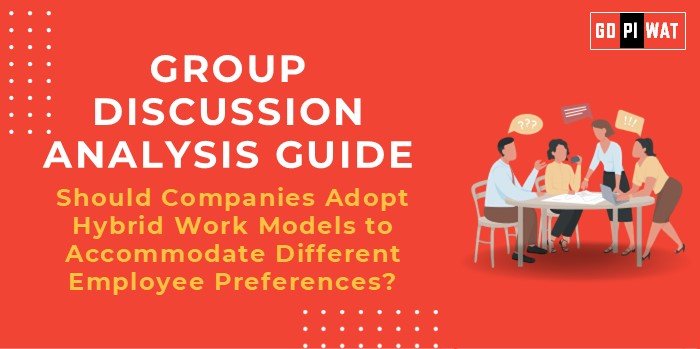📋 Group Discussion (GD) Analysis Guide: Should Companies Adopt Hybrid Work Models to Accommodate Different Employee Preferences?
🌐 Introduction to Hybrid Work Models
- 💡 Opening Context: “With the pandemic reshaping traditional workplaces, hybrid work models have emerged as a critical solution balancing remote flexibility and in-person collaboration. Globally, organizations are redefining productivity and employee satisfaction through such models.”
- 📖 Topic Background: Hybrid work combines remote and office work, allowing employees flexibility to choose their work environment. Popularized during the COVID-19 pandemic, this model addresses both operational efficiency and employee well-being. Recent studies reveal its growing adoption across corporate sectors worldwide.
📊 Quick Facts and Key Statistics
- 🌍 Global Hybrid Adoption: 74% of companies have adopted hybrid models (Gartner, 2024).
- 📈 Productivity Impact: 83% of employees feel equally or more productive under hybrid work (Microsoft Work Index).
- 👩💻 Employee Preferences: 61% of workers favor a hybrid schedule over fully remote or in-office work (McKinsey, 2023).
- 💰 Cost Efficiency: Companies report up to 20% savings on operational costs through hybrid implementation (PwC, 2023).
🤝 Stakeholders and Their Roles
- 🏢 Employers: Implement policies ensuring collaboration, flexibility, and productivity while managing infrastructure and operational costs.
- 👨💻 Employees: Balance work preferences with output expectations, contributing to performance under flexible environments.
- 📋 HR Teams: Redesign policies for remote collaboration, engagement, and performance evaluation.
- 💻 Technology Providers: Offer collaboration tools, cybersecurity solutions, and digital infrastructure for seamless hybrid operations.
- 🏛️ Governments: Frame labor laws addressing hybrid work concerns, ensuring fair practices and employee well-being.
🏆 Achievements and Challenges
✨ Achievements:
- 📈 Increased Productivity: Microsoft reported a 30% efficiency improvement with hybrid schedules.
- 🤝 Employee Retention: Hybrid models reduce turnover by 35% due to higher job satisfaction.
- 🌍 Diverse Talent Pools: Companies access global talent without geographical barriers.
- 💰 Cost Savings: Reduced real estate and operational expenses.
⚠️ Challenges:
- ⏳ Work-Life Boundaries: Blurred personal-professional lines increase burnout risks.
- 🔄 Collaboration Issues: Decreased spontaneous team interactions affect creativity.
- 🔐 Cybersecurity Concerns: Remote work creates vulnerabilities to data breaches.
🌍 Global Comparisons:
- 🇺🇸 USA: Google and Apple adopted hybrid policies to balance innovation and flexibility.
- 🇩🇪 Germany: Hybrid models are legally supported to accommodate worker rights.
📚 Case Study:
- 🏢 TCS (India): Transitioned to a hybrid model with the “25/25” policy—25% of employees work from offices by 2025, showing enhanced employee satisfaction and reduced costs.
🗣️ Structured Arguments for Discussion
- ✅ Supporting Stance: “Hybrid models enhance productivity, attract diverse talent, and save costs—key for modern businesses striving for growth.”
- ❌ Opposing Stance: “Hybrid work undermines team cohesion, challenges communication, and hampers innovation compared to in-person collaboration.”
- ⚖️ Balanced Perspective: “While hybrid work boosts flexibility and productivity, companies must address collaboration gaps and work-life imbalances.”
💡 Effective Discussion Approaches
📜 Opening Approaches:
- “74% of companies globally have embraced hybrid work models.”
- “Is the hybrid model the future of work, or does it undermine long-term innovation?”
🔍 Counter-Argument Handling:
- “While collaboration issues exist, tools like Slack and Zoom have significantly bridged communication gaps.”
📈 Strategic Analysis of Strengths and Weaknesses
- 🏅 Strengths: Enhanced flexibility, reduced costs, increased employee satisfaction.
- ⚠️ Weaknesses: Collaboration gaps, cybersecurity risks, management challenges.
- 💡 Opportunities: Global talent recruitment, digital infrastructure expansion.
- ⚡ Threats: Employee burnout, inequality in remote access, resistance to change.
🎓 Connecting with B-School Applications
- 📚 Real-World Applications: Hybrid models can inspire B-school projects in HR policy innovation, change management, and cost-benefit analysis for businesses.
- 💬 Sample Interview Questions:
- “How would you address collaboration challenges in a hybrid work model?”
- “What role does technology play in successful hybrid work adoption?”
- 🔑 Insights for B-School Students:
- Understand the balance between flexibility and performance metrics.
- Study hybrid success stories for project frameworks.
- Explore technology’s role in enhancing hybrid productivity.


